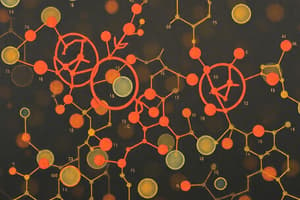Podcast
Questions and Answers
What substances are the starting components for the biosynthesis of heme?
What substances are the starting components for the biosynthesis of heme?
- Glycine and alanine
- Glycine and cholesterol
- SuccinylCoA and fructose
- SuccinylCoA and glycine (correct)
What happens to urine in individuals with porphyrias?
What happens to urine in individuals with porphyrias?
- It becomes discolored, ranging from pink to dark purplish. (correct)
- It turns blue under UV light.
- It has an increased acidity.
- It becomes colorless.
What effect does the accumulation of uroporphyrinogen have on teeth?
What effect does the accumulation of uroporphyrinogen have on teeth?
- They become decayed and discolored.
- They exhibit a green fluorescence.
- They show red fluorescence under UV light. (correct)
- They become overly sensitive to hot and cold.
Which enzyme converts biliverdin to bilirubin during heme degradation?
Which enzyme converts biliverdin to bilirubin during heme degradation?
What is the color of biliverdin, the intermediate product of heme degradation?
What is the color of biliverdin, the intermediate product of heme degradation?
Which amino acids are synthesized from α-ketoglutarate?
Which amino acids are synthesized from α-ketoglutarate?
What is the role of pyridoxal phosphate (PLP) in transamination reactions?
What is the role of pyridoxal phosphate (PLP) in transamination reactions?
Which component is the primary nitrogen source for non-essential amino acid synthesis in mammals?
Which component is the primary nitrogen source for non-essential amino acid synthesis in mammals?
Which of the following is considered a non-essential amino acid?
Which of the following is considered a non-essential amino acid?
What intermediate is phenylalanine derived from in mammals?
What intermediate is phenylalanine derived from in mammals?
The synthesis of which amino acid is directly dependent on ribose 5-phosphate?
The synthesis of which amino acid is directly dependent on ribose 5-phosphate?
What is the primary role of ribonucleotide reductase in nucleotide metabolism?
What is the primary role of ribonucleotide reductase in nucleotide metabolism?
Which enzyme catalyzes the conversion of glutamate to glutamine?
Which enzyme catalyzes the conversion of glutamate to glutamine?
Which anticancer drug directly inhibits thymidylate synthase?
Which anticancer drug directly inhibits thymidylate synthase?
What is the consequence of total lack of hypoxanthine-guanine phosphoribosyl transferase (HGPRT) in Lesch-Nyhan Disease?
What is the consequence of total lack of hypoxanthine-guanine phosphoribosyl transferase (HGPRT) in Lesch-Nyhan Disease?
What is a common characteristic of amino acids synthesized through transamination?
What is a common characteristic of amino acids synthesized through transamination?
What is the final product of purine catabolism as through xanthine oxidase?
What is the final product of purine catabolism as through xanthine oxidase?
What is the function of dihydrofolate reductase (DHFR) in nucleotide synthesis?
What is the function of dihydrofolate reductase (DHFR) in nucleotide synthesis?
What is a primary contributor to the development of gout?
What is a primary contributor to the development of gout?
Which treatment option for gout involves the use of xanthine oxidase inhibitors?
Which treatment option for gout involves the use of xanthine oxidase inhibitors?
Which of the following foods should be avoided to help prevent gout attacks?
Which of the following foods should be avoided to help prevent gout attacks?
What is a product of pyrimidine catabolism?
What is a product of pyrimidine catabolism?
Which amino acid is a precursor to the neurotransmitter GABA?
Which amino acid is a precursor to the neurotransmitter GABA?
Allopurinol is used in treating gout because it inhibits which enzyme?
Allopurinol is used in treating gout because it inhibits which enzyme?
Which disease can occur due to HGPRT deficiency?
Which disease can occur due to HGPRT deficiency?
What is the byproduct of thymine degradation in pyrimidine metabolism?
What is the byproduct of thymine degradation in pyrimidine metabolism?
What is the primary pigment responsible for the yellow color of urine?
What is the primary pigment responsible for the yellow color of urine?
Which of the following conditions is primarily associated with jaundice due to bilirubin accumulation?
Which of the following conditions is primarily associated with jaundice due to bilirubin accumulation?
What is the first step in de-novo purine synthesis?
What is the first step in de-novo purine synthesis?
Which enzyme is considered the rate-limiting step in purine biosynthesis?
Which enzyme is considered the rate-limiting step in purine biosynthesis?
Which substance is converted to a non-toxic form during phototherapy for infant jaundice?
Which substance is converted to a non-toxic form during phototherapy for infant jaundice?
What pathway produces UMP, the precursor to UTP in pyrimidine biosynthesis?
What pathway produces UMP, the precursor to UTP in pyrimidine biosynthesis?
What role does aspartate play in the biosynthesis of pyrimidines?
What role does aspartate play in the biosynthesis of pyrimidines?
Which of the following statements regarding UDP-glucuronosyl transferase is correct?
Which of the following statements regarding UDP-glucuronosyl transferase is correct?
Flashcards
Porphyrias
Porphyrias
Genetic disorders in heme biosynthesis.
Heme biosynthesis
Heme biosynthesis
Creation of heme from succinyl-CoA and glycine.
Bilirubin
Bilirubin
Yellow pigment formed from heme degradation.
Heme oxygenase
Heme oxygenase
Signup and view all the flashcards
Biliverdin reductase
Biliverdin reductase
Signup and view all the flashcards
Amino acid biosynthesis
Amino acid biosynthesis
Signup and view all the flashcards
Non-essential amino acids
Non-essential amino acids
Signup and view all the flashcards
Transamination
Transamination
Signup and view all the flashcards
Pyridoxal Phosphate (PLP)
Pyridoxal Phosphate (PLP)
Signup and view all the flashcards
Essential amino acids
Essential amino acids
Signup and view all the flashcards
Glutamine synthesis
Glutamine synthesis
Signup and view all the flashcards
Metabolic precursors for amino acids
Metabolic precursors for amino acids
Signup and view all the flashcards
Decarboxylation
Decarboxylation
Signup and view all the flashcards
Major pigment of urine
Major pigment of urine
Signup and view all the flashcards
Jaundice cause
Jaundice cause
Signup and view all the flashcards
Bilirubin excretion method
Bilirubin excretion method
Signup and view all the flashcards
Infant jaundice phototherapy
Infant jaundice phototherapy
Signup and view all the flashcards
Purine synthesis start molecule
Purine synthesis start molecule
Signup and view all the flashcards
Rate-limiting purine synth enzyme
Rate-limiting purine synth enzyme
Signup and view all the flashcards
Purine synthesis inhibition
Purine synthesis inhibition
Signup and view all the flashcards
Pyrimidine synthesis Difference
Pyrimidine synthesis Difference
Signup and view all the flashcards
Ribonucleotide to Deoxyribonucleotide
Ribonucleotide to Deoxyribonucleotide
Signup and view all the flashcards
Making dTMP
Making dTMP
Signup and view all the flashcards
Salvage Pathway
Salvage Pathway
Signup and view all the flashcards
HGPRT Enzyme
HGPRT Enzyme
Signup and view all the flashcards
Lesch-Nyhan Disease
Lesch-Nyhan Disease
Signup and view all the flashcards
Gout
Gout
Signup and view all the flashcards
Uric Acid Excretion
Uric Acid Excretion
Signup and view all the flashcards
Gout Treatment
Gout Treatment
Signup and view all the flashcards
Pyrimidine Catabolism
Pyrimidine Catabolism
Signup and view all the flashcards
Thymine Degradation
Thymine Degradation
Signup and view all the flashcards
Xanthine Oxidase Inhibitors
Xanthine Oxidase Inhibitors
Signup and view all the flashcards
Uricase
Uricase
Signup and view all the flashcards
Purine vs. Pyrimidine Catabolism
Purine vs. Pyrimidine Catabolism
Signup and view all the flashcards
Study Notes
Amino Acid and Nucleotide Biosynthesis
- Amino acid biosynthesis originates from intermediates of glycolysis and the citric acid cycle.
- Different amino acids originate from various metabolic precursors.
- Glutamine is derived from glutamate in a two-step process catalyzed by glutamine synthetase. Phosphorylation of glutamate creates a good leaving group, facilitating displacement by ammonia.
- Non-essential amino acids are synthesized from ammonia and keto acids through transamination.
- Transaminations utilize pyridoxal phosphate (PLP), the active form of vitamin B6, and are catalyzed by amidotransferases. PLP forms a Schiff base with the lysine residue of the aminotransferase.
- Bacteria synthesize all 20 amino acids, whereas mammals require some from their diet.
Biosynthesis of Amino Acids and Nucleotides
- Non-essential amino acids are derived from ammonia and keto acids via transamination.
- Transamination utilizes pyridoxal phosphate (PLP).
- PLP is the vitamin B6 active form
- PLP catalyzes reactions by amidotransferases.
- PLP's aldehyde group forms a Schiff base with the lysine residue of aminotransferase.
Overview of Amino Acid Synthesis
- Bacteria are capable of synthesizing all 20 amino acids.
- Mammals require some amino acids from their diet.
- Glutamate (or glutamine) provides the nitrogen atoms (N) for amino acid synthesis.
- The amino acids are synthesized from 7 intermediates of glycolysis and the citric acid cycle.
- The pentose phosphate pathway is involved in the synthesis process
α-Ketoglutarate, Pyruvate, 3-Phosphoglycerate, and Oxaloacetate Families
- Amino acids are classified based on their metabolic precursors.
- α-Ketoglutarate is a precursor for glutamate, glutamine, proline, and arginine.
- Pyruvate is a precursor for alanine, valine, leucine, and isoleucine.
- 3-Phosphoglycerate is a precursor for serine, glycine, and cysteine.
- Oxaloacetate is a precursor for aspartate, asparagine, methionine, threonine, and lysine.
Porphyrins
-
Porphyrins are synthesized from succinyl CoA and glycine.
-
The process involves ALA synthase, which produces α-aminolevulinic acid, and porphobilinogen synthase, which converts two molecules of α-aminolevulinic acid into porphobilinogen.
-
Errors in porphyrin synthesis can lead to porphyria.
-
The symptoms of porphyria relate to the accumulation of porphyrin precursors in body fluids and red blood cells.
-
Porphyrias are often associated with urine discoloration and teeth fluorescence under UV light.
-
Some porphyrias cause an increased sensitivity to UV light.
Heme Degradation and Bile Pigments
- Heme, derived from the breakdown of old red blood cells, is degraded to bilirubin.
- Biliverdin, a green pigment, is an early intermediate.
- Bilirubin, a yellow pigment, is transported in the bloodstream bound to serum albumin.
- Bilirubin is converted to urobilin, the main pigment in urine, and stercobilin, the pigment in feces, by intestinal microbes.
- Jaundice results from bilirubin accumulation, often due to liver diseases, bile duct blockages, or UDPGT deficiency.
- Infant jaundice can be treated with phototherapy.
Purine Biosynthesis
- Purine synthesis begins with PRPP (5-phosphoribosyl-1-pyrophosphate).
- Multiple enzymes, including glutamine-PRPP amidotransferase, are involved in the process.
- Feedback inhibition by purine nucleotides regulates purine synthesis.
- Some anticancer drugs, such as 6-mercaptopurine and 6-thioguanine, inhibit purine synthesis.
Pyrimidine Biosynthesis
- Pyrimidine synthesis produces the pyrimidine ring first and then attaches it to ribose-5-phosphate.
- Aspartate and carbamoyl phosphate provide atoms for the pyrimidine ring structure.
- UMP is phosphorylated to UTP.
- UTP can be converted to CTP via amination.
Ribonucleotide to Deoxyribonucleotide Conversion
- Ribonucleotides are converted to deoxyribonucleotides by ribonucleotide reductase.
- This involves using NADPH as a reducing agent and glutathione, and FAD.
- The conversion involves reduction of the 2'-C-OH bond to a 2'-H bond.
dTMP from dUMP
- dTMP is synthesized from dUMP.
- Thymidylate synthase catalyzes the reaction, utilizing methyl groups from tetrahydrofolate.
- 5-fluorouracil (5-FU), floxuridine, and capecitabine are thymidylate synthase inhibitors used as anticancer drugs.
- Methotrexate is an inhibitor of dihydrofolate reductase (DHFR) which is part of the pathway that produces tetrahydrofolate required for thymidylate synthase activity.
Purine and Pyrimidine Degradation
- Nucleases degrade DNA and RNA into individual nucleotides.
- Excess nucleotides are catabolized via salvage pathways or de novo pathways to avoid accumulation.
- Purine degradation produces uric acid, which is excreted in humans or converted to allantoin in most mammals.
- Pyrimidine degradation leads to the production of ammonia and urea, along with CAC intermediates.
Excess Uric Acid and Gout
- Excess uric acid can cause gout, characterized by the formation of sodium urate crystals in joints, primarily affecting males.
- Gout can be caused by overproduction or insufficient excretion of uric acid, and/or overconsumption of fructose.
- Treatment options include dietary modifications (avoiding purine-rich foods) and medications such as allopurinol (a xanthine oxidase inhibitor) or febuxostat (another xanthine oxidase inhibitor).
- The administration of porcine uric acid oxidase (uricase) can also be used to treat gout.
Drugs and Diseases
- Essential amino acids and coenzymes, such as pyridoxal phosphate (PLP), are necessary for biosynthesis.
- Certain drugs, such as 5-fluorouracil, 6-mercaptopurine, 6-thioguanine, and methotrexate, are used in treating specific diseases as well as in the synthesis of nucleotides.
Studying That Suits You
Use AI to generate personalized quizzes and flashcards to suit your learning preferences.




